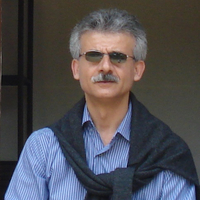Papers by jürgen fingerle
International Symposium on Atherosclerosis, May 1, 2015
Circulation, Oct 28, 2008
Mast cells are abundantly present in perivascular tissue during atherosclerotic plaque progressio... more Mast cells are abundantly present in perivascular tissue during atherosclerotic plaque progression and were previously demonstrated to contribute significantly to plaque destabilization. In this st...
Investigative Ophthalmology & Visual Science, 2018
Arteriosklerotische Gefäßerkrankungen, 1992
Die Migration glatter Muskelzellen (SMC), die Synthese und der Abbau extrazellularer Matrix in de... more Die Migration glatter Muskelzellen (SMC), die Synthese und der Abbau extrazellularer Matrix in der arteriellen Gefaswand sind zentrale Prozesse, die zur Entstehung einer arteriosklerotischen Neointima im Tiermodell fuhren [1, 2, 4]. Als eine Voraussetzung fur die Migration von SMC aus der Media in die Intima wird angenommen, das die Zellen ihre Basalmembran und die extrazellulare Matrix auflosen und reorganisieren mussen.
Helvetica chirurgica acta, 1993

Laboratory investigation; a journal of technical methods and pathology, 1989
Endothelial regeneration in the rat carotid artery was investigated using two different technique... more Endothelial regeneration in the rat carotid artery was investigated using two different techniques of denudation. With balloon catheter denudation, medial cell death occurred, and endothelial regrowth stopped after several weeks, leaving a large area devoid of endothelium. After denudation with a new technique that removed the endothelium without damaging the media complete endothelial regrowth was achieved. Acutely after this denudation, large platelet thrombi were present on the subendothelial surface of vessels denuded with the filament loop. In contrast, balloon catheter denuded arteries showed only a platelet monolayer on their luminal surface. Within the first few weeks after denudation with either technique the regenerating endothelial cells stained strongly for basic fibroblast growth factor. At later times when replication of endothelium had stopped, the balloon catheter denuded vessels did not stain with this antibody. After filament denudation endothelial cell replication...

Basic research in cardiology, 1991
Sympathetic nerves and catecholamines seem to have a trophic influence on vascular smooth muscle ... more Sympathetic nerves and catecholamines seem to have a trophic influence on vascular smooth muscle cells in vivo. We therefore tested whether alpha 1-antagonists would inhibit proliferation in arterial smooth muscle in vivo. Smooth muscle cells were stimulated to form a neointima in rat carotid arteries after deendothelialization by means of a 2F embolectomy catheter. The development of intimal lesions was determined 14 days after injury. The size of the neointima was measured using two parameters. Intimal DNA content was estimated from 5-mm segments of carotid arteries after DNA extraction and staining with Hoechst-stain. The size of the neointima was determined morphometrically as intimal area in histological cross-sections. Prazosin and urapidil were given orally once per day. Urapidil-treated rats showed significant inhibition of neointima formation for both parameters in a dose-dependent fashion. For prazosin a significant reduction could only be observed if DNA content was consi...

Circulation, 1992
This review discusses the role of growth factors on the proliferation of smooth muscle cells (SMC... more This review discusses the role of growth factors on the proliferation of smooth muscle cells (SMCs) in injured arteries. We have used a variety of procedures to injure rat carotid arteries and noted that removal of endothelium followed by platelet adherence does not always initiate SMC replication. Furthermore, thrombocytopenia did not reduce the early SMC replication induced by balloon catheter injury. Platelet-derived growth factor (PDGF) has been found to exert little effect on SMC replication but markedly influences the ability of SMCs to migrate to the intima. Basic fibroblast growth factor (bFGF) is a potent mitogen for SMCs in denuded arteries while having no effect on cells in control uninjured arteries. We have hypothesized that arterial injury leads to release of bFGF from injured SMCs and so stimulates cell replication. Rats were treated with antibodies to bFGF immediately before balloon injury, and this significantly reduced the SMC replication. These findings suggest th...

Tissue and Cell, 1989
Rabbit aorta explants in organ culture maintained their endothelium as a confluent cell layer for... more Rabbit aorta explants in organ culture maintained their endothelium as a confluent cell layer for 1-6 days. Depending on culture time, interendothelial tight junctions underwent gradual morphological changes in their substructure, as seen in freeze-fracture replicas. The formation of a P-face associated groove and concurrent confluence of tight junction particles on E-faces after 24hr in vitro was followed by a rarefaction of particles and shortening of tight junctional strands. By day 6 in vitro, almost all tight junctions have dissappeared. We interprete these findings as signs of a degradation of tight junctions in vitro, involving three different substructural components: a component facing the protoplasm, tight junction particles and a component facing the extracellular space. The degradation was inhibited by culturing under increased ambient pressure (910mmHg).
The Journal of Membrane Biology, 1982
Experimental Cell Research, 1988
Biochemical and Biophysical Research Communications, 1995











Uploads
Papers by jürgen fingerle